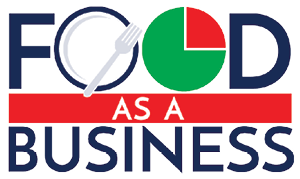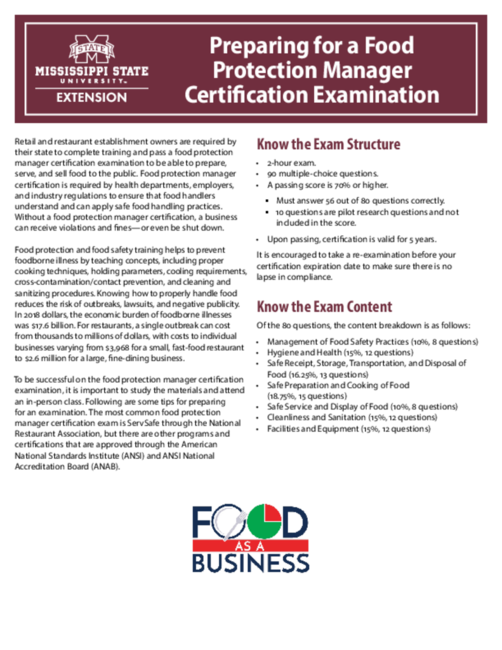P4137
Preparing for a Food Protection Manager Certification Examination

Retail and restaurant establishment owners are required by their state to complete training and pass a food protection manager certification examination to be able to prepare, serve, and sell food to the public. Food protection manager certification is required by health departments, employers, and industry regulations to ensure that food handlers understand and can apply safe food handling practices. Without a food protection manager certification, a business can receive violations and fines—or even be shut down.
Food protection and food safety training helps to prevent foodborne illness by teaching concepts, including proper cooking techniques, holding parameters, cooling requirements, cross-contamination/contact prevention, and cleaning and sanitizing procedures. Knowing how to properly handle food reduces the risk of outbreaks, lawsuits, and negative publicity. In 2018 dollars, the economic burden of foodborne illnesses was $17.6 billion. For restaurants, a single outbreak can cost from thousands to millions of dollars, with costs to individual businesses varying from $3,968 for a small, fast-food restaurant to $2.6 million for a large, fine-dining business.
To be successful on the food protection manager certification examination, it is important to study the materials and attend an in-person class. Following are some tips for preparing for an examination. The most common food protection manager certification exam is ServSafe through the National Restaurant Association, but there are other programs and certifications that are approved through the American National Standards Institute (ANSI) and ANSI National Accreditation Board (ANAB).
Know the Exam Structure
- 2-hour exam.
- 90 multiple-choice questions.
- A passing score is 70% or higher.
- Must answer 56 out of 80 questions correctly.
- 10 questions are pilot research questions and not included in the score.
- Upon passing, certification is valid for 5 years.
It is encouraged to take a re-examination before your certification expiration date to make sure there is no lapse in compliance.
Know the Exam Content
Of the 80 questions, the content breakdown is as follows:
- Management of Food Safety Practices (10%, 8 questions)
- Hygiene and Health (15%, 12 questions)
- Safe Receipt, Storage, Transportation, and Disposal of Food (16.25%, 13 questions)
- Safe Preparation and Cooking of Food (18.75%, 15 questions)
- Safe Service and Display of Food (10%, 8 questions)
- Cleanliness and Sanitation (15%, 12 questions)
- Facilities and Equipment (15%, 12 questions)
Review and Study the Course Materials Before the Class
The book and materials are usually sent to participants in advance of a class.
- Thoroughly read the Food Protection Manager book.
- Review chapter summaries.
- Review case studies.
- Complete the study questions at the end of each chapter.
- Become familiar with the chapter charts and their related content.
It is highly encouraged to read the book chapters and complete the chapter assessments before attending a training and/or examination.
Use Videos and Supplemental Resources
Many entities distribute information and videos to support restaurant and retail food safety education, including these:
- Land-grant universities
- Extension Services
- National and state regulatory agencies
- National and state trade organizations
Create Study Resources
- Create your own study guide and flashcards to help retain content. Focus on critical numbers, content, and themes.
- Study in short, consistent sessions. For example, study for 30–45 minutes a day or read one chapter a day.
- After reading the chapters, focus on weaker content areas as the class and exam date get closer.
- Memorize critical numbers related to cooking, storage, handling, and temperature control.
Identify Differences Between Concepts, Practices, and Applications
Many retail food protection and safety concepts are similar, but there are differences. Often, what makes them different is important during the exam and can help reduce the number of possible answers. Here are some concepts, practices, and applications to focus on:
- Cleaning versus sanitizing
- Cross-contamination versus cross-contact
- Temperature control for safety (TCS) foods versus non-temperature control for safety foods (non-TCS)
- Contamination and hazards
- Spoilage (quality) versus pathogenic (safety)
Attend a Face-to-Face Class
Classes are provided regularly in most states, including Mississippi, and are an opportunity to receive the information in a different format. You can also ask instructors questions during classes.
Instructors may use a variety of materials, including videos, activities, case studies, games, and presentations. Some instructors may cover additional test-preparation and multiple-choice questions. Instructors are prohibited from going over the actual examination questions or assisting directly with questions during the examination process.
Take Practice Exams
- Review as many multiple-choice questions as possible.
- Complete practice tests.
- Your instructor may provide general practice tests.
- The book chapters have study questions.
- Review missed questions and related content. Focus on understanding why an answer is correct.
Question the Questions
- Read questions carefully and thoroughly. Some questions are designed to be tricky to test your situational knowledge and awareness.
- Use logic when deciding an answer.
- What is the most realistic answer in the situation?
- What is the safest food safety approach?
Exam Content and Context Clues
Food protection manager certification exams are multiple choice.
- Know the distinction between different topics. For example, many pathogens have similar symptoms, but jaundice is only associated with hepatitis A.
- Use the process of elimination of answers to your advantage. Generally, it is easy to reduce the question down to two potential answers.
- You can always flag a question and come back later to review it.
Summary
It is important to study and prepare for the food protection manager certification examination by thoroughly reading the book, taking the assessments, reviewing the case studies, identifying key concepts on the charts and tables, and taking practice exams. The in-person class should be a review of material you have already studied and an opportunity to ask an instructor questions on concepts.
Learn more about MSU Extension’s Food Protection Manager Certification online.
References and Resources
American National Standards Institute (ANSI)
American National Standards Institute National Accreditation Board (ANAB)
Bartsch, S. M., Asti, L., Nyathi, S., Spiker, M. L., & Lee, B. Y. 2018. Estimated Cost to a Restaurant of a Foodborne Illness Outbreak. Public Health Reports, 133(3), 274–286.
Conference for Food Protection
National Restaurant Association
ServSafe – National Restaurant Association
United States Department of Agriculture – Economic Research Service. 2025. Cost Estimates of Foodborne Illnesses
United States Food and Drug Administration (FDA). 2022. Food Code

This work is supported by the Extension Risk Management Education Program, project award no. 2023-70027-40446, from the U.S. Department of Agriculture’s National Institute of Food and Agriculture.
Any opinions, findings, conclusions, or recommendations expressed in this publication are those of the author(s) and should not be construed to represent any official USDA or U.S. Government determination or policy.
The information given here is for educational purposes only. References to commercial products, trade names, or suppliers are made with the understanding that no endorsement is implied and that no discrimination against other products or suppliers is intended.
Publication 4137 (POD-09-25)
By Courtney Crist, PhD, Associate Extension Professor, Biochemistry, Nutrition, and Health Promotion.
The Mississippi State University Extension Service is working to ensure all web content is accessible to all users. If you need assistance accessing any of our content, please email the webteam or call 662-325-2262.
